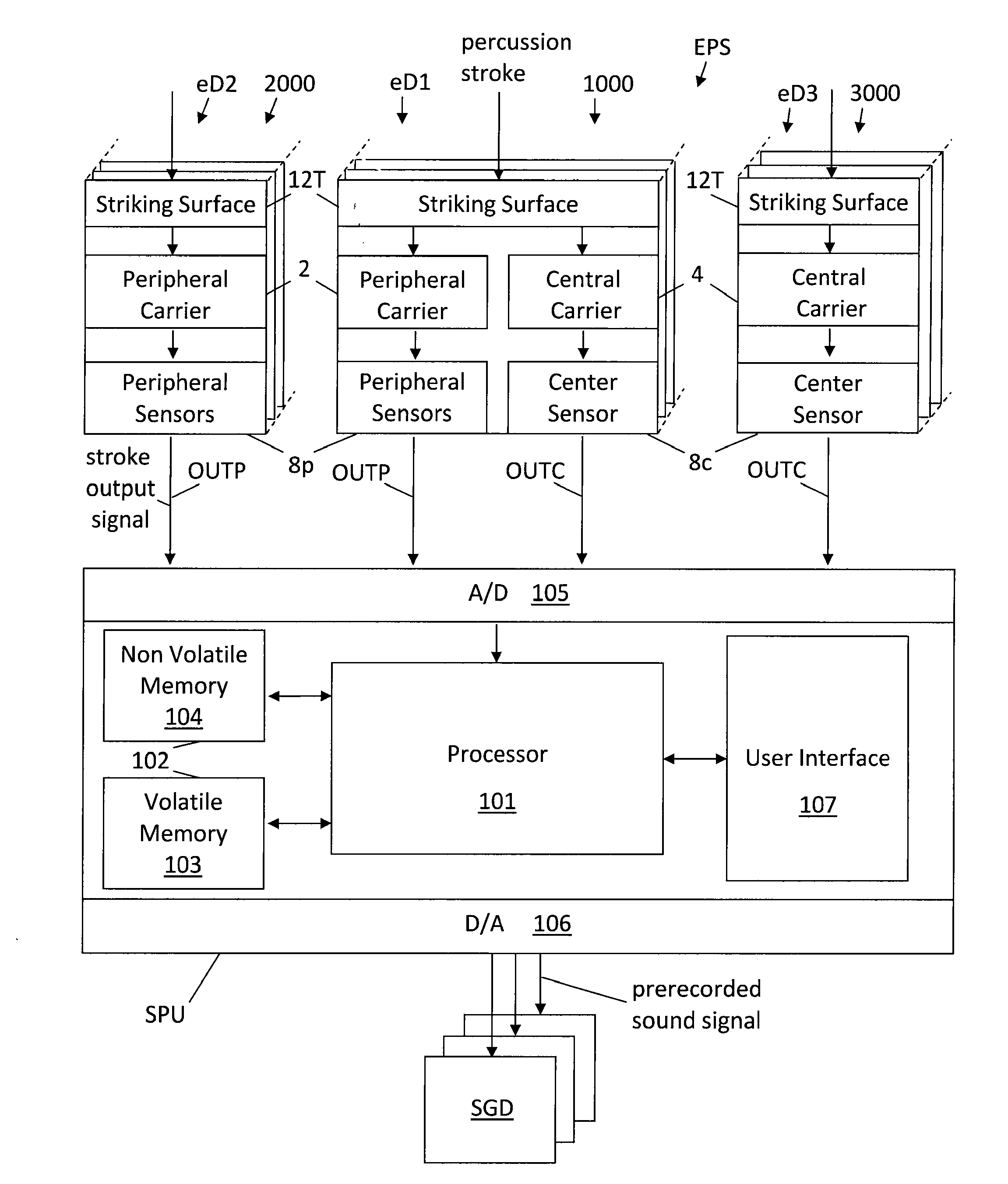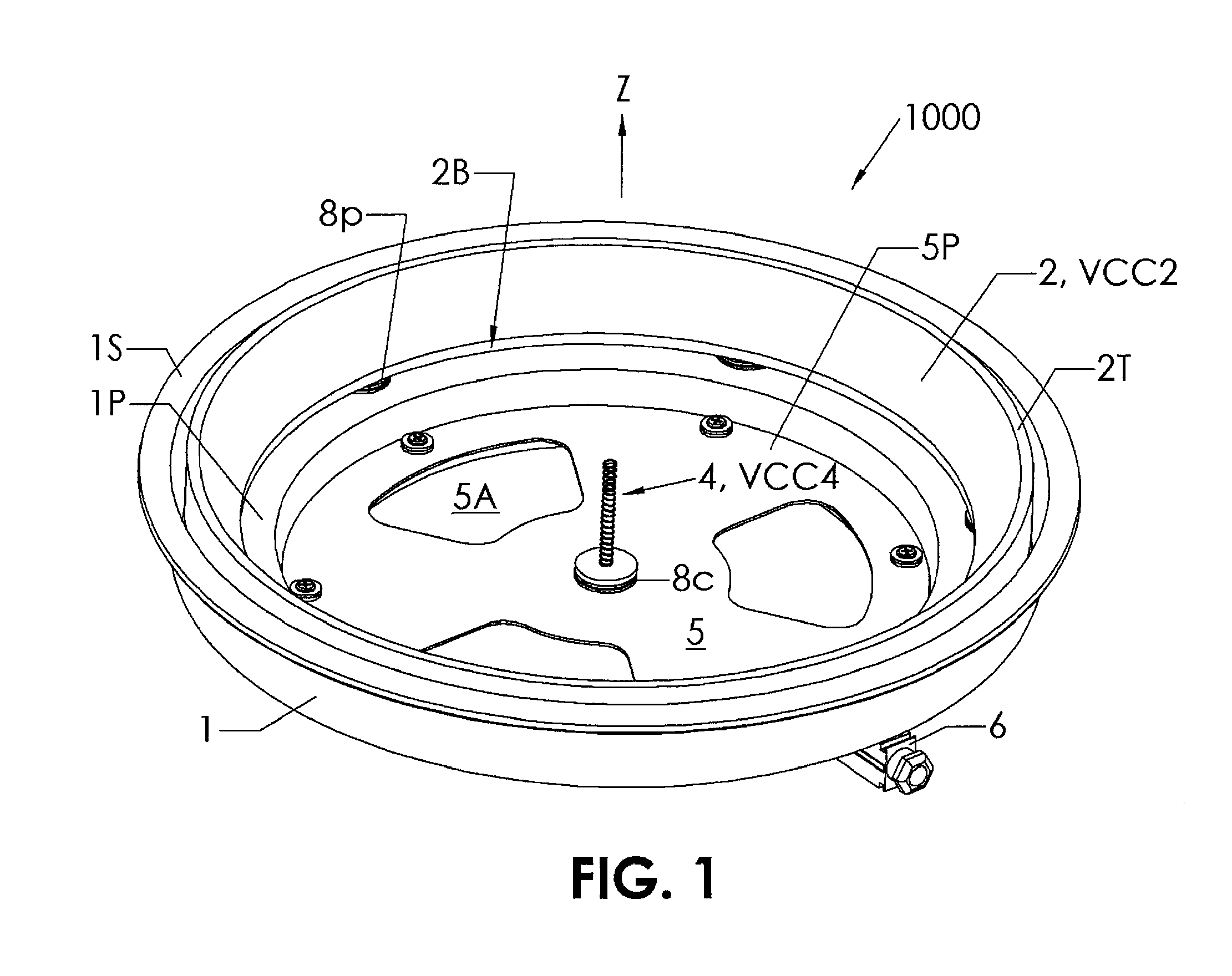Electronic percussion device and method
a technology of electronic percussion and percussion instruments, applied in the direction of measuring devices, electrophonic musical instruments, instruments, etc., can solve the problems of delay in sound reproduction in response to a trigger that cannot be noticed even by the trained ear of a musician, and the second portion is considered inferior, and the related art does not address this problem at all
- Summary
- Abstract
- Description
- Claims
- Application Information
AI Technical Summary
Benefits of technology
Problems solved by technology
Method used
Image
Examples
embodiment 1000
[0108]The description hereinbelow refers mainly to the structure of the embodiment 1000 even though the alternative embodiments are applicable and practical too.
[0109]Reference is now made to FIG. 4, which illustrates a schematic representation of an exemplary electronic percussion system EPS which has a plurality of electronic percussion devices eD of various embodiments, such as for example the electronic percussion devices eD1, eD2 and eD3, and so on. However, the electronic percussion system EPS may also be operated with just one single electronic percussion device eD or with more than one electronic percussion device eD of the same or of different embodiment.
[0110]FIG. 4 shows three different embodiments of the present invention, namely the embodiment 1000 having at least one peripheral sensor 8p and a center sensor 8c, embodiment 2000 with only peripheral sensors 8p, and embodiment 3000 including only the center sensor 8c. The embodiments 1000, 2000, and 3000 are marked respec...
embodiment 3000
[0214]As described hereinabove and shown in steps S17-S24 in FIG. 13, should a new stroke output signal be detected, then the state of the primary channel would not be Idle. Furthermore, after the detection of a new percussion signal feature, it is also known whether the percussion stroke is a normal percussion stroke or a rim shot. If in step S44 the state of the primary channel is Idle, then the function returns, preserving the Idle state of the procedure step S14. However, if the state of the primary channel is not Idle, then control is passed to step S45 where the channel is checked for detection of a normal percussion stroke or of a rim shot. In the embodiments 1000 and 2000, the primary channel is defined to be the peripheral channel and therefore, the decision between a normal percussion stroke and a rim shot is made with excellent results. In the embodiment 3000, it is the central channel that is checked so that the decision is made with good results, although not as good as...
embodiment 2000
[0216]The process continues to step S49, which is called iteratively in a loop of the main audio process when the state is set to NormalSound, where each new iteration updates the sounds that are generated with a more accurate estimation. This is done until the transient period elapses for all the channels available with the current percussion device. For the embodiment 1000 and 3000, this occurs when the available channels exit the SearchMax state, at which point both maximum values of the sound signals are known, and the position and intensity results are accurate. For the embodiment 2000, the transient period elapses only after exiting the SearchMax and SearchMin state, as will be described hereinbelow.
[0217]As described hereinabove, the estimation process in step S49 was introduced in order to minimize the delay, knowing that it is much more important to output an inaccurate sound signal as quickly as possible and to care for an update later on, rather than to wait until all the...
PUM
 Login to View More
Login to View More Abstract
Description
Claims
Application Information
 Login to View More
Login to View More - R&D
- Intellectual Property
- Life Sciences
- Materials
- Tech Scout
- Unparalleled Data Quality
- Higher Quality Content
- 60% Fewer Hallucinations
Browse by: Latest US Patents, China's latest patents, Technical Efficacy Thesaurus, Application Domain, Technology Topic, Popular Technical Reports.
© 2025 PatSnap. All rights reserved.Legal|Privacy policy|Modern Slavery Act Transparency Statement|Sitemap|About US| Contact US: help@patsnap.com



